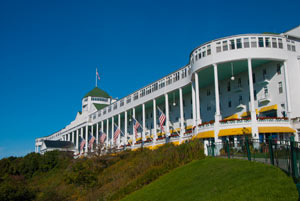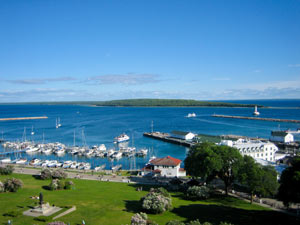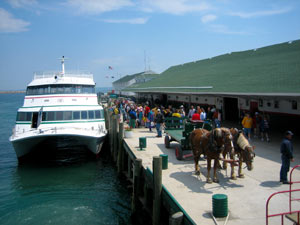
Before the sun rises, the docks are bustling. Percherons snort and stomp, waiting for the wagons to fill as dock workers scurry up and down the ramp. Cartons of frozen food come fresh off the freezer truck on the ferryboat’s deck to be stacked in wooden wagons. Loading complete, the drays move out, a steady clip-clop of the horses hooves echoing down the streets toward Mission Point, the Grand Hotel and points in between. Teams and drivers deliver their most perishable loads of the day before the streets once again fill with today’s visitors to America’s only island that moves at a horse’s pace—Mackinac Island.
The horse culture of Mackinac Island, Michigan, is truly a way of life. From a jaunt from home to the grocery store and UPS deliveries to a taxi ride to the airport or ferryboat, this very Victorian island in the Great Lakes is entirely dependent on horses.
“We’re not the Amish,” says Brad Chambers with a laugh. “That’s the biggest misunderstanding about Mackinac.” Brad is a fifth-generation islander from a long line of carriage drivers. His family operates the dray service and oversees Mackinac Island Carriage Tours, a cooperative dating back to the 1920s that manages most of the working horses on the island.
Mackinac’s distinctive horse-drawn lifestyle dates back to a proclamation by the Mackinac Island Village Council in 1898 that banned horseless carriages from city streets. Concerns ran deep that these newfangled machines would wreak havoc on their peaceful island, which sits just off the Straits of Mackinac, separating the Upper Peninsula of Michigan from the rest of the state.
In 1900, summer cottager Earl C. Anthony brought his new Locomobile over on the ferryboat, thumbing his nose at the ban. Sure enough, the engine startled the horses, several carriages wrecked and horses were injured. After this incident, the Mackinac Island State Park Commission banned cars from the state park, which covers 80 percent of the island. Since 1901, the only engine-driven wheeled vehicles permitted on the island are a small fleet of emergency vehicles, tucked away discreetly except when in use; golf carts limited to golf course use; and the rare special-permit use of construction vehicles for major efforts like rebuilding the airport runway. Building a house? Your concrete blocks and wood arrive by dray.
From the moment you step off the ferryboat on the downtown docks—or arrive by private plane at the airport—you’ll see horses and carriages taking care of business. Not just taxicabs and tours but delivery services, garbage trucks, lawn services, family transportation, even workers headed to their jobs. One exception: The post office does not deliver. It’s up to you to pick up your mail.
On Mackinac Island, your transportation choices are simple: walk, ride a bike, ride a horse or drive a carriage.
“It’s pretty neat,” says Leanne Brodeur, a Mackinac Island native and founder of the Mackinac Horsemen’s Association. “I grew up here and had ponies since I could shovel manure and saddle them up myself.” Leanne oversees the Mackinac Community Equestrian Center, which serves both as a boarding stable for residents’ horses and runs the 4-H program for the island. This is a stable that horses were involved in building. “Pretty much everything here was hauled in by dray,” Leanne says. “They allowed us to truck in some of the stuff that was just too big and heavy, like the steel sheeting.”
The Mackinac Horsemen’s Association holds one big fundraiser each summer, the Festival of the Horse. Running for several days in August, it enables visitors to peek into Victorian-era cottager stables, see formal carriages on parade and watch Musical Freestyle performances with Friesians. Presentations showcase the variety of breeds on the island, and lecturers share the unique aspects of island horse culture. During the rest of the summer season, visitors are welcome to visit the community stables.
“None of the other barns allow anybody in,” says Leanne, “so we’re looking forward to showing it off.”

A Grand Stage
Acrossroads on the waters of the Great Lakes for centuries for Native American tribes, French fur traders and British soldiers, Mackinac Island is one of many islands where Lake Huron and Lake Michigan meet. The Ojibwa called the island Michilimackinac, the Great Turtle, for its prominent shape as seen from a canoe. French voyageur Jean Nicolet discovered the island and its indigenous people on his 1634 expedition, and by 1671, Mackinac Island was the most important fur trading post on the American frontier. Controlled by the British during the American Revolution and the War of 1812, the island resumed its status as a fur-trading mecca under the auspices of John Jacob Astor during the 1820s. Moving on to commercial fishing and shipping after the fur trade tapped out, the establishment of Mackinac Island National Park (now a state park and National Historic Site) after the Civil War shifted the island’s focus to tourism.
Pre-dating the fuss about automobiles, the Grand Hotel opened its doors in 1887 after a 93-day whirlwind of construction. Built by a consortium of shipping interests, the Grand Hotel was meant to attract the newfound leisure class of the children of the titans of America’s industrial revolution. The late 1800s ushered in Victorian “cottages” built by the very wealthy along the island’s main avenues and high bluffs as well as quaint hotels and inns lining the streets of downtown. The Grand Hotel stands out thanks to its sheer size—you can’t miss it as you arrive by ferryboat—and its flair for keeping the island’s Victorian image and horse culture alive.

“The biggest challenge we have is to represent all of the periods of the hotel’s history, put it together in this wild, eclectic mix and make it work,” says Grand Hotel Historian Bob Tagatz. “We’re a summer hotel. We’re elegant, but we don’t want to take ourselves too seriously. It’s a theatrical experience.” One of less than a dozen Gilded Age hotels remaining in the United States, the Grand Hotel flourished thanks to three generations of ownership by the same family, the Mussers. “It is the only institution I have ever been associated with where the president, the chairman and the vice president grew up as kids in the building,” says Bob. “They grew up with their guests. So I always say we were created for our guests, but we’re also created by our guests.”
“At the Grand Hotel we have the fun part of the horse culture,” says Ben Mosley, a year-round Mackinac Island resident and the stable master of the Grand Hotel. “A stay at the Grand Hotel is kind of a choreographed show, with our horses the opening and closing acts of the show.”The show begins with the arrival of a 1901 Fisher Omnibus at the Arnold Ferry Line docks, a courtesy shuttle for incoming guests. “We use the Percheron horses to pull the Omnibuses. I prefer grays because they look better in photographs,” says Ben. “Our carriages, horses and drivers stand out downtown, and we do that on purpose. We use a harness that isn’t even traditional for that carriage; it’s a harness for showing Draft horses in an arena. Our drivers are slightly overdressed for the carriage that they’re driving… a formal livery. As a general rule, when the drivers put that livery on, their persona changes. It’s all part of the showmanship.”
Once you arrive at the hotel, you’re treated to the gentle ‘clip-clop’ of horses along the avenue out front as part of the ambiance, as carriages continually arrive and depart. Carriages are used to transport golfers across The Jewel from the 1901-era Grand Nine—home of the Jockey Club Restaurant—to the Woods Nine, a more modern course. Some guests treat themselves to private carriage rides.
“Everything we have is rolling stock,” says Ben, “and we try to use every carriage every year so we can keep saying that. It’s surprising how well balanced and smooth they are to ride.” The hotel’s collection includes several of William Vanderbilt’s carriages, one of which is a late 1800s Bachelor Brougham, and a Brewster Vis-à-vis built in 1904 for U.S. Senator George Hazelton, part owner in the Union-Pacific Railroad.
After more than a century inside the hotel itself, starting off in the basement and moving to separate quarters uphill, the Grand Hotel’s stables are now offsite in a prominent location at the top of Surrey Hill. Built in partnership with Mackinac Island Carriage Tours, the stables are home to both a new Antique Carriage Museum and the working horses of the Grand Hotel.

Team Effort
Near the Arnold docks, a team of Percherons stands waiting as a “surrey with the fringe on top” loads up with eager tourists. Thousands of visitors disembark from the ferries every summer day, and one of their top choices for exploring the island is a two-hour tour with Mackinac Island Carriage Tours. Providing an overview of the historic downtown as well as a ride along the deeply shaded roads of the state park, it’s the best way to get your bearings on what’s where. Mackinac Island offers many temptations, from its dozens of competing fudge shops on Main Street to historic Fort Mackinac atop the bluffs and numerous unusual geologic formations, including Sugar Loaf and Arch Rock.
To serve the summer throngs, there are more than 500 working horses, outnumbering the year-round residents. Most are stabled at Surrey Hill. Ben stopped our carriage near their stables.
“Now you’re in the middle of a whole bunch of stables, and the flies should just be swarming,” he said, “but this is as bad as it gets.” Which wasn’t bad at all. Dr. Al Sibinic runs the fly eradication program. “He educated people,” says Ben, “and uses fly predators, a hybrid bug, that they put out every five or six days. They also have people maintaining their compost piles better.”Throughout the island, you’ll see men with large shovels and wheeled carts making sure that the roads stay clean.
“Any commercial vehicle that has a license on it, they’re responsible for a given area of the street to maintain,” says Ben. “The city and state pick up the rest of it.” All of the waste, including food and paper scraps from the hotels, ends up at a one-of-a-kind composting facility well away from the tourist and residential areas. “Believe it or not, it draws a few tourists,” says Ben.

Belgian Draft and Percherons handle the heavy commercial loads and account for the majority of the island’s horses. High-stepping Hackney horses pull the dressiest of private carriages. Welsh Cobs and Friesians are local favorites for personal carriages and riding. It’s not unusual to spot a Norwegian Fjord pony or even a Thoroughbred in someone’s yard. On a carriage ride through the Annex, the summer cottage community in the woods above the West Bluff, you’ll notice stables and carriage homes adjoining the houses, sometimes even eclipsing them in size. There aren’t as many obvious in Harrisonville, where most year-round working residents live.
“You really don’t have time to care for a horse,” says Ben. “Everyone has to make hay while the sun shines.” Instead, bicycles are their main means of transportation. At the end of the season, most working horses are shipped off-island to farms in the Upper Peninsula. Full-time residents switch to snowmobiles during the winter months.
Although most visitors opt for bicycle rentals to circle the island—an 8.2 mile loop at lake level—there are those for whom a horse is a must. Jack’s Livery Stable offers drive-your-own carriages, with gentle horses that know the established routes. Both Jack’s and Cindy’s Riding Stable offer guided trail rides on the island’s nearly 77 miles of trails.
“The people who take the drive-it yourself carriages, that’s got to be hard because you’re going from 75 miles an hour down I-75 to a horse’s pace,” says Leanne. “But if you can just relax, enjoy it and go with it,” you’ve discovered the magic of Mackinac Island.
IF YOU GO
Mackinac Island is located in the Straits of Mackinac between Lake Huron and Lake Michigan, where Upper Michigan and Lower Michigan meet. Several ferry lines depart Mackinaw City on a regular schedule between May and October and less frequently in the off-season. Ice socks in the island in the dead of winter, closing down transportation options. Mackinaw City is 20 hours north of Ocala off I-75 exit 338 in Michigan, just south of the Mackinac Island Bridge.
Arnold Transit Co./ arnoldline.com
Cindy’s Riding Stable / cindysridingstable.com
Grand Hotel / grandhotel.com
Jack’s Livery Stable / jacksliverystable.com
Mackinac Island / mackinac.com
Mackinac Island Carriage Tours / mict.com
Mackinac Island Festival of the Horse / mackinacislandfestivalofthehorse.org
Mackinac Island Horseman’s Association/ mackinachorses.org
Mackinac State Historic Parks / mackinacparks.com
Mission Point/ missionpoint.com






